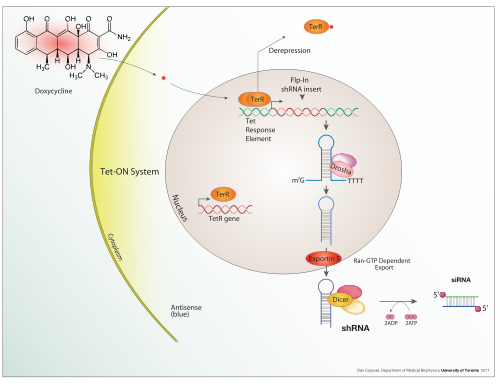
Tetracycline-controlled transcriptional activation is a method of inducible gene expression where transcription is reversibly turned on or off in the presence of the antibiotic tetracycline or one of its derivatives (e.g. doxycycline).[1]
Tetracycline-controlled gene expression is based upon the mechanism of resistance to tetracycline antibiotic treatment found in gram-negative bacteria. In nature, the Ptet promoter expresses TetR (the repressor) and TetA, the protein that pumps tetracycline antibiotic out of the cell.[2]
The difference between Tet-On and Tet-Off is not whether the transactivator turns a gene on or off, as the name might suggest; rather, both proteins activate expression. The difference relates to their respective response to tetracycline or doxycycline (Dox, a more stable tetracycline analogue); Tet-Off activates expression in the absence of Dox, whereas Tet-On activates in the presence of Dox.
- ^ Gossen M, Freundlieb S, Bender G, Müller G, Hillen W, Bujard H (June 1995). "Transcriptional activation by tetracyclines in mammalian cells". Science. 268 (5218): 1766–9. Bibcode:1995Sci...268.1766G. doi:10.1126/science.7792603. PMID 7792603.
- ^ Orth P, Schnappinger D, Hillen W, Saenger W, Hinrichs W (2000). "Structural basis of gene regulation by the tetracycline inducible Tet repressor-operator system" (PDF). Nature Structural & Molecular Biology. 7 (3): 215–219. doi:10.1038/73324. PMID 10700280. S2CID 19973826.